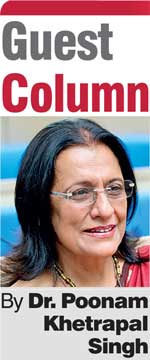Friday Jan 16, 2026
Friday Jan 16, 2026
Wednesday, 24 January 2018 00:06 - - {{hitsCtrl.values.hits}}
After vanquishing polio, the South-East Asia Region continues to make life-saving advances in newborn and child health
Seven years ago this month, the South-East Asia Region recorded its last case of wild polio virus. In 2014, three years later, the region was declared polio-free. Not a single case of wild polio virus has been recorded region-wide since, sparing millions of children the risk of contracting the paralysing and life-threatening disease. The region’s achievement, and its contribution to global polio eradication, is one of the world’s great public health success stories.
Our progress continues. Last year, three million more children in the region survived the first five years of life than in 1990 – the most dramatic reduction anywhere in the world. The region’s contribution to global under-five mortality meanwhile dropped to 25%, down from 37% at the start of the same period. The region has now achieved the Millennium Development Goal target for under-five mortality, while a few of its member countries have already surpassed the child health-related Sustainable Development Goals. In short, across the South-East Asia Region, more children than ever are not only surviving, but are growing into strong, healthy and productive adults. To maintain this trajectory and ensure all countries achieve the Sustainable Development Goal (SDG) targets, accelerated progress is nevertheless needed. By 2030 all countries should have reduced under-five mortality to at least as low as 25 per 1000 live births, while neonatal mortality should be at least as low as 12 per 1000 live births. Maternal mortality – a related concern – should meanwhile be reduced to less than 70 per 1000 live births. To achieve these targets, concerted action is needed.
First, member countries should expand access to good quality health services, especially for women, children and adolescents, with universal health coverage (UHC) remaining a top priority. Through targeted investments countries can greatly reduce each of the leading causes of maternal, newborn and under-five deaths (a Regional Flagship Priority), including complications associated with prematurity, pneumonia, birth asphyxia, diarrhoea, sepsis and birth defects. Notably, better services will have the added benefit of encouraging institutional deliveries. As per the Decade of Action on Human Resources for Health, a good way to achieve  these outcomes is by recruiting more health workers, advancing the skills of health workers at all levels of care, and finding innovative ways to retain health workers in rural and hard-to-reach areas. Second, and complementary to UHC, Member countries should focus on mitigating cause- and context-specific mortality. Even where national averages are good, for example, children belonging to poor or marginalised groups can suffer mortality rates well above national levels, often due to easily preventable diseases such as pneumonia or diarrhoea. By pursuing equitable access to safe water and sanitation and reducing indoor air pollution, for example, Member countries can forge progress that not only reduces mortality from these diseases, but also – crucially – helps ensure no child is left behind. This is especially so when combined with the promotion of health-positive habits such as handwashing and toilet usage generally, and exclusive breastfeeding for the first six months of a child’s life specifically.
these outcomes is by recruiting more health workers, advancing the skills of health workers at all levels of care, and finding innovative ways to retain health workers in rural and hard-to-reach areas. Second, and complementary to UHC, Member countries should focus on mitigating cause- and context-specific mortality. Even where national averages are good, for example, children belonging to poor or marginalised groups can suffer mortality rates well above national levels, often due to easily preventable diseases such as pneumonia or diarrhoea. By pursuing equitable access to safe water and sanitation and reducing indoor air pollution, for example, Member countries can forge progress that not only reduces mortality from these diseases, but also – crucially – helps ensure no child is left behind. This is especially so when combined with the promotion of health-positive habits such as handwashing and toilet usage generally, and exclusive breastfeeding for the first six months of a child’s life specifically.
And third, we must not be complacent. Member countries should continue to strengthen routine immunisation programs, including surveillance. In recent years enhanced routine immunisation has been responsible for some of the Region’s greatest achievements in newborn, child and maternal health, including the elimination of maternal and neonatal tetanus. As the Region strives to eliminate measles – a major childhood killer – by 2020, Member countries must ensure each and every child receives two doses of the combined measles and rubella vaccine. To their immense credit, Bhutan and Maldives have already eliminated the disease, demonstrating that the 2020 target is readily achievable.
Importantly, Member countries must go beyond the ‘survival agenda’ and aim to ensure that every child in the Region can live, grow and thrive in an era of unrivalled opportunity. That means ensuring every child is adequately nourished and has the energy needed to engage in physical activity and play. It means ensuring every child lives in an environment where health hazards are mitigated or removed, and where early childhood development is invested in and nurtured, especially during the first three years of life. And it means ensuring that as every child grows into adolescence they can access the health services needed to navigate a phase of life that has its own special needs.
Each one of these outcomes and more can be achieved. As the region’s victory over polio attests, a whole generation’s health and wellbeing can be dramatically enhanced when the right priorities are set and society-wide commitment is secured. As countries across the region strive to reduce newborn, child and maternal mortality to levels at or below the SDG threshold, this opportunity must be fully grasped. Our children are our future. A healthier tomorrow must begin today.
The writer is the WHO Regional Director